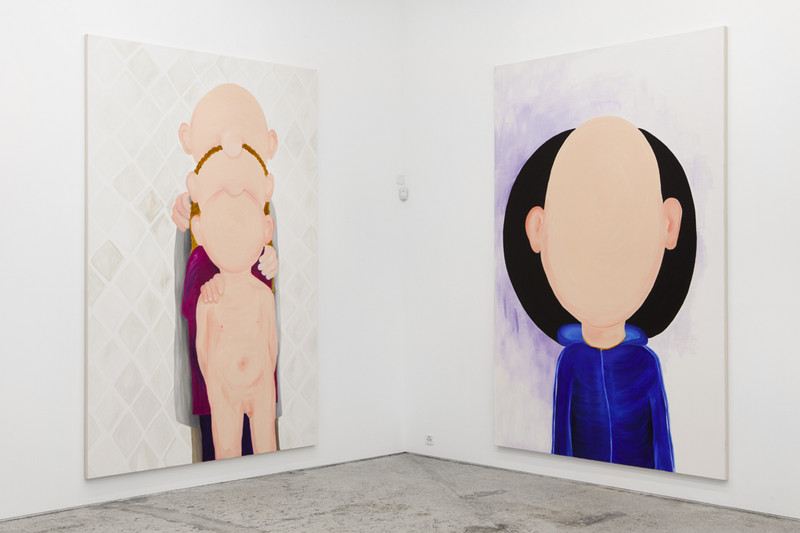Heike Kati Barath
05 May - 02 Jun 2012
HEIKE KATI BARATH
mannomann
5 May – 2 June 2012
Immediately upon entering the exhibition «mannomann» by Heike Kati Barath, a large friendly being walks toward us on a huge canvas and smiles. It seems as if we, the beholders, have been looked at and expected for a long time already. The marionette-like wooden figure seems amused and cheerful, but its head is stuck onto a wood pole and emblematizes what has often been said about Barath’s figures: they make us laugh, yet with a bitter touch.
We also encounter a wooden structure on the opposite wall. This construction of rods and slats forms a face, and allows the work to become a portrait. A board on the lower margin of the image, like a ramp, leads inside the image and to the figure, a ladder-like arrangement of slats suggests access to the light structure, which with its twisted perspectives and instability at these airy heights generates a latent sense of mistrust. Where are we, surrounded by sky blue and painted striated clouds? And what could we see from this assembled wooden head, much like a raised blind?
Barath’s painting is virtuosic. Close up, we can recognize the dynamic flow and the refined depiction of the slightly brittle wood executed in a perfection that approaches that of the old masters. The complex, various painterly technique contrasts with the reduction of the visual program that leads to an immediacy and a directness.
Barath’s works are inspired by literature and film, recalling fairy tales, comics, or horror movies, but above all Barath observes bodily postures, facial expressions, and gestures in everyday life that are reduced in such a way that they become appearances and generally valid memories. This goes so far so that in the family portrait exhibited, in which the nose of each figures overlaps with the forehead of the respective figure before it, as well as in the portrait of a someone wearing a hoodie placed before a black disc, all physiognomy is left out, posing questions of familiarity and anonymity. The comic and the tragic, the idyllic and the brutal lie close to one another, just as in the additional canvas works and the small format paper works. And an openness and ambivalence opens up, quite in the sense of the expanse of sky with no fixed point behind the wood constructions.
Julia Schmidt
mannomann
5 May – 2 June 2012
Immediately upon entering the exhibition «mannomann» by Heike Kati Barath, a large friendly being walks toward us on a huge canvas and smiles. It seems as if we, the beholders, have been looked at and expected for a long time already. The marionette-like wooden figure seems amused and cheerful, but its head is stuck onto a wood pole and emblematizes what has often been said about Barath’s figures: they make us laugh, yet with a bitter touch.
We also encounter a wooden structure on the opposite wall. This construction of rods and slats forms a face, and allows the work to become a portrait. A board on the lower margin of the image, like a ramp, leads inside the image and to the figure, a ladder-like arrangement of slats suggests access to the light structure, which with its twisted perspectives and instability at these airy heights generates a latent sense of mistrust. Where are we, surrounded by sky blue and painted striated clouds? And what could we see from this assembled wooden head, much like a raised blind?
Barath’s painting is virtuosic. Close up, we can recognize the dynamic flow and the refined depiction of the slightly brittle wood executed in a perfection that approaches that of the old masters. The complex, various painterly technique contrasts with the reduction of the visual program that leads to an immediacy and a directness.
Barath’s works are inspired by literature and film, recalling fairy tales, comics, or horror movies, but above all Barath observes bodily postures, facial expressions, and gestures in everyday life that are reduced in such a way that they become appearances and generally valid memories. This goes so far so that in the family portrait exhibited, in which the nose of each figures overlaps with the forehead of the respective figure before it, as well as in the portrait of a someone wearing a hoodie placed before a black disc, all physiognomy is left out, posing questions of familiarity and anonymity. The comic and the tragic, the idyllic and the brutal lie close to one another, just as in the additional canvas works and the small format paper works. And an openness and ambivalence opens up, quite in the sense of the expanse of sky with no fixed point behind the wood constructions.
Julia Schmidt

